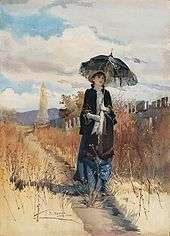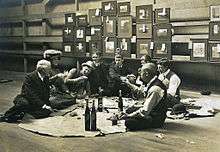Julian Ashton

Julian Rossi Ashton CBE (27 January 1851 – 27 April 1942) was an English-born Australian artist and teacher, known for his support of the Heidelberg School and for his influential art school in Sydney.
Biography

Ashton was born in Addlestone, Surrey, the son of American amateur painter[1] Thomas Briggs Ashton, and his wife Henrietta, daughter of Count Carlo Rossi,[2] a Sardinian diplomat[3] who married the soprano Henriette Sontag. The family moved to Penzance, Cornwall shortly after, and lived at Burley Grove, Gulval.[4] His father died in 1864, and around age 15 he began working in the engineers' office of either the Great Western Railway[5] or Great Eastern Railway.[6] There he remained for 6 years using his entire leisure time painting at South Kensington. He then went to Paris to study and began illustrating books. He also had considerable success as a painter, exhibiting at the Royal Academy of Arts and elsewhere.
Ashton emigrated to Melbourne in 1878 under contract to David Syme's Illustrated Australian News and lived there for 5 years before moving to Sydney. He had a background in the contemporary French realism of the Barbizon School, which emphasised painting en plein air (i.e. direct from nature, as opposed to studio-based painting), and which laid the basis for the Impressionist movement. As a trustee of the Art Gallery of New South Wales he championed emerging Australian artists of the Australian Impressionist or Heidelberg School, and the Gallery's decision to collect these works owes much to his influence. Ashton is known for his paintings Evening, Merri Creek (1882), A Solitary Ramble (1888) and others.
George Lambert painted a portrait of Ashton which is in the Art Gallery of New South Wales. Lambert showed Ashton, then 77, with white hair and a military-type moustache, dressed in a grey suit and a dapper bow-tie, cigar in hand, sitting beside a table with a mass of objects. The cigar and wine suggest 'good living' and the flowers and fruit may have referred to Ashton's role as a gardener. Behind him there is a deep red curtain draped over a gold picture frame, behind which there is a curtain, creating an abstract arrangement of bold colours, with the frame suggesting Ashton's role as an artist, teacher and patron.[7]
Julian Ashton Art School

The Sydney Art School (also known as the Julian Ashton Art School), which Ashton established in 1890 as the "Academy Julian",[8] (perhaps a reference to the Académie Julian in Paris) has been an influential art school in Australia.
Julian Ashton students have included Elioth Gruner, George Lambert, B. E. Minns, Thea Proctor, Adrian Feint, Sydney Long, Howard Ashton (Julian's son), Dorrit Black, J. J. Hilder, William Dobell, Edmund Arthur Harvey, Eric Wilson, Jean Bellette, Douglas Dundas, Arthur Freeman, William Dadswell, John Passmore, Yvonne Audette, Joshua Smith, Max Dupain, John Olsen, Michael Johnston, Jim Russell, Florence Turner Blake, Sydney Ure Smith, Alexander McKenzie, Brett Whiteley, Susan Dorothea White, Nigel Thomson, Nora Heysen and Salvatore Zofrea. The poet Lola Ridge (1873–1941) also studied with him.
After Julian Ashton died in 1942, the school was run by Henry Gibbons (1884–1972). Henry Gibbons had started at the school as a student in April 1919 and soon became the teacher of the night drawing classes. In 1924 Gibbons proposed starting a Saturday afternoon class so that he could teach some of the night drawing students to paint. The Saturday class started in February 1924 and the first nine students were Dobell, Dundas, Passmore, Badham, Lawrence, Brackenreg, Byrne, Hubble and Cox. Gibbons taught many winners of the NSW Traveling Arts Scholarship. Henry Gibbons retired in 1960.
Howard Ashton's son, J. Richard Ashton, and his wife Wenda ran the School from 1960, when, among many gifted artists, Ian Chapman and Archibald Prize winner Francis Giacco attended, until 1977 when Phillip Ashton (Richard's son) became Principal, this being the time of Haydn Wilson, political cartoonist Bill Leak and artist Paul Newton.
In 1988 the school was incorporated and Paul Delprat, Julian Ashton's great-grandson, himself an ex-student took over the running of the school, becoming the current Principal. In 1989 the school's antique casts and easels, which date back to 1890, were classified by the National Trust. The school's main campus is in The Rocks, Sydney, located opposite the Museum of Contemporary Art Australia. Since 2004 the school has also conducted classes at Headland Park, Georges Heights, Mosman.
The School currently offers: The Sir William Dobell, Brett Whiteley, John Olsen, Thea Proctor, Portrait Artists Australia, Sydney Mechanics' School of Arts and The Art Express scholarships to encourage fine drawing and painting. Samuel Wade, a Brett Whiteley Scholarship winner at the school, went on to win the Brett Whiteley Travelling Art Scholarship at the Art Gallery of New South Wales.
Recognition
He was appointed a Commander of the Order of the British Empire (CBE) in 1930.[8][9]
See also
| Wikimedia Commons has media related to Julian Ashton. |
References
- ↑ http://artsearch.nga.gov.au/Detail.cfm?IRN=16115 National Gallery of Australia
- ↑ Serle, Percival (1949). "Ashton, Julian Rossi". Dictionary of Australian Biography. Sydney: Angus and Robertson.
- ↑ http://acms.sl.nsw.gov.au/item/itemdetailpaged.aspx?itemid=431505 State Library of New South Wales
- ↑ The Cornishman 28 March 1889
- ↑ "Julian Ashton Was Artists' Guide & Friend.". The Courier-Mail. Brisbane: National Library of Australia. 29 April 1942. p. 4. Retrieved 30 April 2013.
- ↑ Katherine Harper, 'Ashton, Julian Rossi (1851–1942)', Australian Dictionary of Biography, National Centre of Biography, Australian National University, accessed 30 April 2013
- ↑ Gray,193.
- 1 2 ''Sydney Morning Herald'' 27 January 1931. Trove.nla.gov.au (27 January 1931). Retrieved on 26 August 2011.
- ↑ It's an Honour
Bibliography
- Serle, Percival (1949). "Ashton, Julian Rossi". Dictionary of Australian Biography. Sydney: Angus and Robertson.
- Gray, Anne. George W Lambert Retrospective – Heroes and Icons. Canberra: National Gallery of Australia, 2007. ISBN 978-0-642-54121-5.
External links
- Works by or about Julian Ashton at Internet Archive
- Website for Julian Ashton Art School
- Julian Ashton at Australian Art